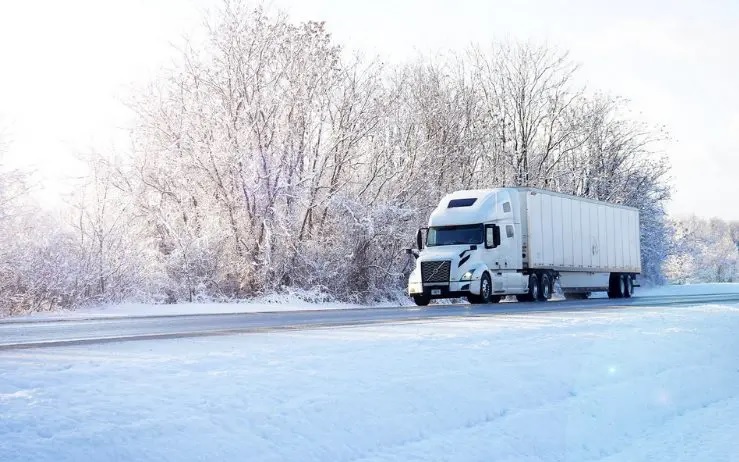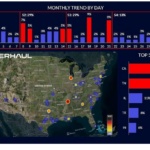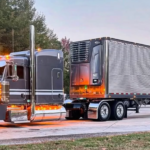Above and beyond what is experienced by regular-sized vehicles, commercial trucks are extremely susceptible to dangerous winter conditions. Even if you are an extremely experienced and highly skilled truck driver, winter driving conditions can present challenges. Wet or icy roads make it difficult for trucks to handle a load and make it difficult for you as a driver of a big rig to slow your rig down enough to stop. 70% of roads in the United States are in snowy areas, which increases the threat of an accident significantly (FHWA). Today, we look at the 10 truck driving tips for winter.
Slow Down
It’s essential to remember when the roadways are wet, icy, or snow-covered, you must slow down. Even in the best of conditions, speed is a big factor in most eighteen-wheeler accidents. Posted speed limits are for ideal conditions. Reduce your speed when driving on a snow-covered road with poor traction. Slower speeds give you more time to react if anything goes wrong. Use reasonable and prudent speed. Slow down in poor weather conditions. Use lower gears and gentle braking when going downhill. Avoid unnecessary lane changes and passing.
Maintain a Good Distance from Other Vehicles
Slick, wet, icy roads present the perfect conditions for a rear-end collision. Therefore, as a big rig driver, ensure you maintain a safe distance between your truck and other vehicles to ensure you have enough room to stop if the vehicle in front of you stops or slows down suddenly.
There are three things that add up to total stopping distance: Perception Distance + Reaction Distance + Braking Distance = Total Stopping Distance
Perception Distance
The distance your vehicle travels from the time your eyes see a hazard until your brain recognizes it. The perception time for an alert driver is about 3/4 second. At 55 mph, you travel 60 feet in 3/4 second.
Reaction Distance
The distance traveled from when your brain tells your foot to move from the accelerator until your foot is actually pushing the brake pedal. The average driver has a reaction time of 3/4 second. This accounts for an additional 60 feet traveled at 55 mph.
Braking Distance
The distance it takes to stop once the brakes are put on. At 55 mph on dry pavement with good brakes, it can take a heavy vehicle about 170 feet to stop. It takes about 4 1/2 seconds.
Total Stopping Distance
At 55 mph, it will take about 6 seconds to stop, and your vehicle will travel about the distance of a football field. (60 + 60 + 170 = 290 feet).
Increased speeds and increased weights affect stopping distances greatly. The heavier the vehicle, the more work the brakes must do to stop it, and the more heat they absorb. But the brakes, tires, springs, and shock absorbers on heavy vehicles are designed to work best when the vehicle is fully loaded.
Empty trucks require greater stopping distances because an empty vehicle has less traction. It can bounce and lock up its wheels, giving much poorer braking.
Try to Leave the Pack
The tendency for groups of traffic is to travel together in a pack. Although this is fine in regular driving conditions, it’s a good idea to leave the pack and travel alone during inclement weather, thus ensuring enough space between your rig and any other vehicle, as just mentioned in the previous point. Also, staying out of “pack style” traveling can reduce your risk of becoming part of a multi-vehicle accident or pile up on the interstate.
When In Doubt, Pull Over
If the weather condition is too severe to drive, find a safe way to get off the roadway and wait until the weather improves and it’s safe to drive. Read all ZONAR messaging for current weather updates. Assure that your vehicle is equipped with road flares and emergency triangles. Notify Driver Manager of all weather and roadway issues.
Avoid Using The Jake Brake
Many big rig drivers like to implement their jake brakes when weather conditions decline. Ideally, you do not want to engage your jake brake when driving on icy roadways as it can result in your trailer sliding and spinning out of control – especially true when you are transporting an empty trailer.
Check All Systems Before Leaving
It would be best if you always took great care in completing your circle check. However, when conditions are predicted to be dicey, you must pay special attention to your truck. Make sure your mirrors and windows are clean and clear, brakes are set properly, moisture drained from air tanks, and washer fluid is topped off before you depart on your trip. Our truck driving tips for winter also include:
Check that batteries are always fully charged.
Check tire condition and air pressure (PSI).
Check fuel capacity. Do not all allow fuel tanks to be completely
empty.
Check oil and antifreeze-levels and proper oil viscosities.
Check 5th wheel assembly-must be greased.
Top Off Fuel Tanks
You want your rig to be as heavy as possible to give you better traction on icy roadways. Therefore, make sure your fuel tank is full, the tire pressure is correct, and take along some good lug tires to make your rig as steady as possible.
Clean Tractor and Trailer Lights
Be sure to regularly clear the snow and ice from both your tractor and trailer lights. All lights, but especially the LED variety, accumulate crud and snow quickly. Therefore, to ensure drivers around you see you clearly, even in low visibility, make sure your lights are cleared of all ice and snow.
Avoid Sudden Actions
One of the worst things you can do when driving on snow and ice is to break, or do anything at all, suddenly. Winter weather conditions demand you slow down and maintain a consistent speed, without any sudden acceleration, cornering, or braking. If you need to stop because of someone else’s actions, it’s actually better to maneuver around them rather than trying to stop.
Pay Attention to Vehicle Tire Spray
A good tip on how to gauge the ice on the roadway is paying attention to other vehicle’s tire spray. If there is a lot of sprays, you can assume the roadways are wet but not too icy. When you note significantly less spray, you can be sure there is more ice on the roadway, so be extra cautious.
In general, when traveling in the winter, it’s good to have basic supplies, like extra food, water, clothing, and heat source (if possible) in case you get stranded. Also, keep the above driving tips in mind to stay safe even in the worst driving conditions.
Bonus Truck Driving Tip for Winter: Take Care of Yourself
Taking care of yourself is paramount to safe driving in winter
weather conditions. Eat nutritious food and avoid junk food. Eat small frequent meals and snacks to keep your energy level up. Pack extra non-perishable food.
Stay hydrated by drinking plenty of fluids like water, sports drinks, and
juices are critical, especially in cold weather and in higher altitudes.
Rest because your body and mind need rest after driving in winter
conditions. Stop periodically in a safe place to stretch your legs. Take 30-minute rest breaks. Sleep during your 10-hour breaks.
Dress in warm clothing with extras available. A warm jacket, gloves, and proper footwear-boots are critical items.
Additional items to keep in your truck include extra blankets, flashlight, shovel, matches batteries, traction device chairs, and bags of sand.
Source: www.driveknight.com





